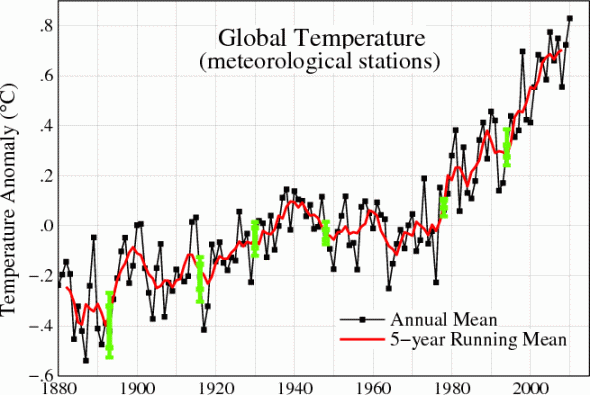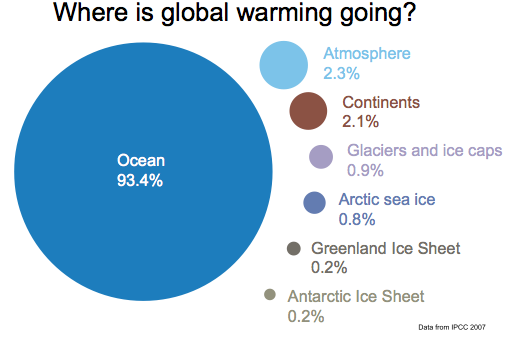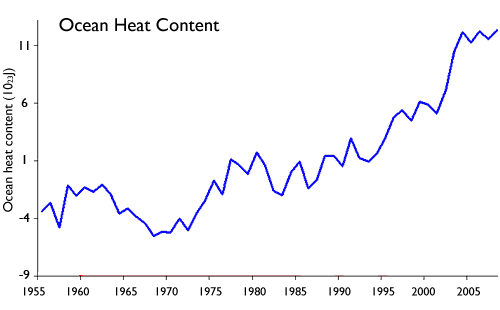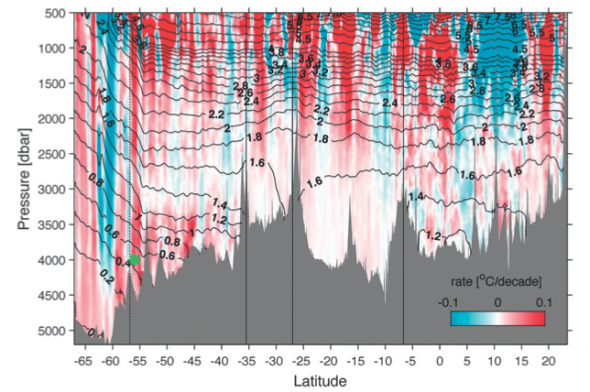Abstract: Large-scale increases in upper-ocean temperatures are evident in observational records1. Several studies have used well-established detection and attribution methods to demonstrate that the observed basin-scale temperature changes are consistent with model responses to anthropogenic forcing and inconsistent with model-based estimates of natural variability2, 3, 4, 5. These studies relied on a single observational data set and employed results from only one or two models. Recent identification of systematic instrumental biases6 in expendable bathythermograph data has led to improved estimates of ocean temperature variability and trends7, 8, 9 and provide motivation to revisit earlier detection and attribution studies. We examine the causes of ocean warming using these improved observational estimates, together with results from a large multimodel archive of externally forced and unforced simulations. The time evolution of upper ocean temperature changes in the newer observational estimates is similar to that of the multimodel average of simulations that include the effects of volcanic eruptions. Our detection and attribution analysis systematically examines the sensitivity of results to a variety of model and data-processing choices. When global mean changes are included, we consistently obtain a positive identification (at the 1% significance level) of an anthropogenic fingerprint in observed upper-ocean temperature changes, thereby substantially strengthening existing detection and attribution evidence.
In plain english that all means that we are warming the oceans by releasing greenhouse gases. Sadly, the Abstract is the most readable part of this paper (and that ain’t saying much). Overall, it is a classic example of very poor technical science writing and overuse of jargon: I’d give this paper a D in my class! For style that is – the content or science is fine.
The team used several new “bias-corrected” data sets from instruments that measure ocean temperature to estimate global and regional trends in ocean warming at various depths. This has been done before. What is new here is that the team compared the predictions of oceanographic models that predict patterns of ocean temperature, with and without “external forcing”, to the field temperature data. This enabled them to determine which models did a good job of predicting the observed temperature patterns.
The computer models are based on essentially everything we know about the physics of the oceans: the currents, how heat is moved around, how natural cycles and occurrences like ENSO and volcanic eruptions affect ocean temperature, etc.. The “external forcing” bit is climate modeler jargon for “humans messing around with the earth’s climate” (“external” as in external to nature – like we are aliens or something!). So the climate model was run with and without an increase in greenhouse gases and the team compared the outcome; only with greenhouse gas emissions from people, does the model predict the ocean warming we’ve seen (and the team is 99% sure this result was not due to chance alone). So there you have it: the oceans are warming and we are the cause.
The bottom line is that this study substantially strengthens the conclusion that most of the observed global ocean warming over the past 50 years is attributable to human activities. Although we performed a series of tests to account for the impact of various uncertainties, we found no evidence that simultaneous warming of the upper layers of all seven seas can be explained by natural climate variability alone. Humans have played a dominant role. – lead author Dr Peter Gleckler of the Lawrence Livermore National Laboratory
To back up a little bit, greenhouse gases we are emitting into the atmosphere trap heat from the sun that would otherwise be reflected off the surface of the earth. This is the greenhouse effect that is causing global warming / Anthropogenic Climate Change (ACC). Most people, including many scientists, think of the warming of the land and lower atmosphere when they think about climate change. For example, the temperature trend in the NASA graph below should look pretty familiar to most readers. It is based on measurements from thousands of terrestrial weather stations.
But what about the oceans, are they warming as well? Incredibley, ~93 percent of the excess heat being trapped by anthropogenic greenhouse gases is being absorbed by the oceans and only 2% by the atmosphere:

Increasing ocean heat content, based on data in Levitus 2009 (which you can download here), replotted by John Cook.
And not just the shallow seas; even the very deep ocean is warming. You can see this trend in this graphic from Purkey and Johnson 2010 that plots the rate of warming across the worlds oceans with latitude on the horizontal axis and depth on the vertical axis. Red areas warmed and blue areas cooled during the study period (1980-2010). One of the very deep areas that is warming the fastest is around Antarctica (on the lower left portion of the graphic around latitude -55). This is especially concerning because this deep warming could affect ocean circulation and accelerate the melting of coastal sea ice in that region, leading to faster sea level rise.
Why does all of this matter?
1) Warming oceans has countless impacts on ocean life and ecosystems including how food webs function, ocean productivity, the metabolism and growth rate of fish and invertebrates and the survival of coral reefs.
2) As ocean water warms, it expands; this thermal expansion is an important component of the rising sea levels we are currently seeing.
3) Much of this excess heat will eventually be released back into the atmosphere, causing further terrestrial warming. This means that the warming on land we are seeing today is mostly due to emissions decades ago.





Leave a Reply